INTRODUCTION
Most American high school students don’t learn a complete history of race relations in the United States before they graduate. By the end of the school year, most history teachers have only reached the 60s or 70s in the textbook. Students are usually taught that Martin Luther King, Jr. and the Civil Rights Movement broke down the Jim Crow system of segregation, Congress passed the Civil Rights and Voting Rights Acts, and that we celebrate Black History Month each February to mark the achievements of great African Americans. Unfortunately, little or no mention is made of the urban riots in Los Angeles in the 1990s, the emotional trial of OJ Simpson, the election of Barack Obama, or challenges to voting rights in the past decade. This is a problem because race relations are an important part of our current national conversation.
Some people might think that we have moved beyond racial division because we elected an African American president. After Obama’s election, some people even talked about a “post-racial America” where we no longer see color. They believed that we had achieved the “promised land” that Martin Luther King, Jr. spoke about when he described his dream for the nation. However, if we look at the news, we can see that this is not true. There is still a lot of evidence that race plays an important role in America, from police shootings to Black Lives Matter protests to football players kneeling during the national anthem. Some people are hopeful that things can change and wonder if we will ever have a post-racial America. What do you think?
SEGREGATION TODAY
Although America has made strides towards racial equality and elected an African American president, the country is still divided along racial lines. This is seen in the demographics of cities like Detroit, where African Americans make up over 78% of the population despite being less than 14% of Michigan’s population. This segregation is not unique to Detroit and has roots in the Great Migration, where African Americans moved to the North for better opportunities but were concentrated into segregated neighborhoods.
This ongoing segregation has led to a lack of opportunities and poverty in these neighborhoods, fueling frustration that has led to violence and gang life. White Flight, where white residents moved to the suburbs, has left predominantly African American communities behind in the urban core. Segregation continues due to factors like redlining and discriminatory hiring practices, making integration unlikely.
Segregation has serious consequences, seen in the mostly neighborhood-based and segregated American schools. African American and Hispanic students attend schools where whites make up 0 to 1% of the enrollment, a common phenomenon in northern cities like Chicago and New York and for Hispanic students in Los Angeles.
The effects of segregation are also evident in the aftermath of natural disasters, like the Flint water crisis and Hurricane Katrina. In Flint, Michigan in 2014, white state officials changed the city’s drinking water source from Lake Huron and the Detroit River to the less expensive Flint River. Due to insufficient water treatment, lead from water pipes got into the drinking water, exposing over 100,000 mostly African American residents to high lead levels. This disaster showed how communities of color are often the ones most hurt by environmental dangers and bad governmental decisions.
Similarly, Hurricane Katrina did a lot of damage in New Orleans in 2005, but hurt African Americans most of all. The Lower Ninth Ward, a mostly African American neighborhood, experienced the worst flooding. Those who lived in areas better protected from flooding and those who were able to get out before the storm, were usually richer and whiter. At the time, President George W. Bush admitted that poverty in the area had “roots in the history of racial discrimination, which cut off generations from the opportunities of America.”
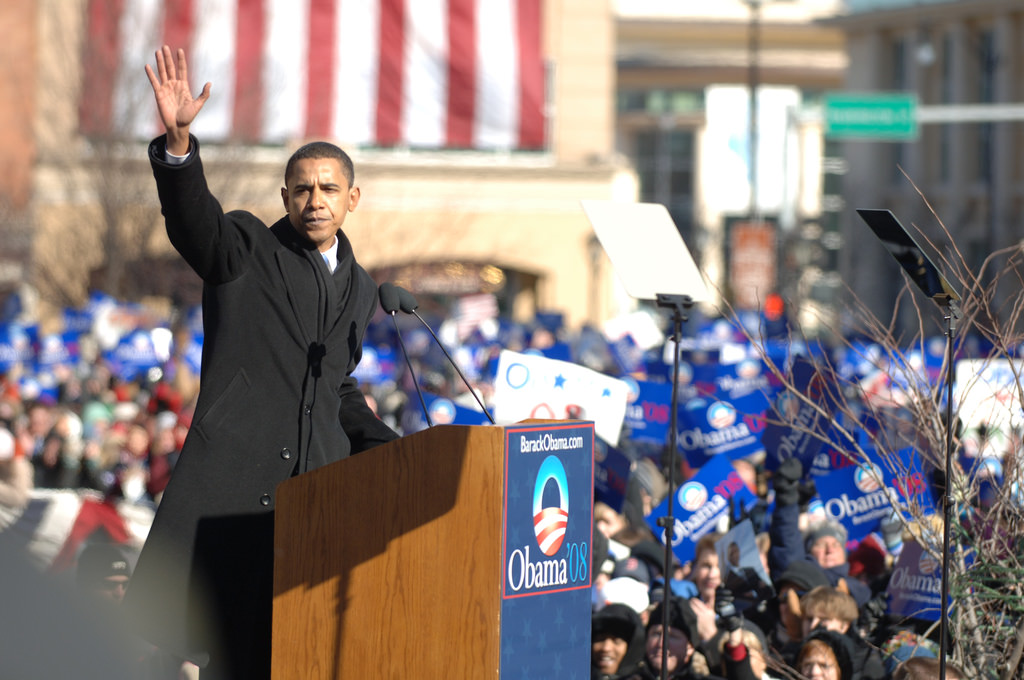 Primary Source: Photograph
Primary Source: Photograph
Senator Barack Obama announcing his candidacy for president in 2007. Obama went on to defeat Hillary Clinton in the Democratic primary and then John McCain in the general election. He won reelection in 2012, serving eight years as the nation’s first African American president.
BARACK OBAMA
Barack Obama, the country’s first African American president, was elected in 2008. At the time, the largest group of voters were the Baby Boomers who had grown up during the Civil Rights Movement and fought for equal rights during the 1960s. Obama’s election was seen by many as a sign that the country had become post-racial. However, opinions on this topic were divided by race.
Obama promoted the idea that America was overcoming its divided past. In his keynote speech at the 2002 Democratic National Convention, he said, “There’s not a black America and white America and Latino America and Asian America; there’s the United States of America.” He also addressed the issue of race during his campaign in a speech entitled A More Perfect Union, where he talked about the need to move beyond old racial wounds.
During his presidency, Obama worked on reforming the criminal justice system to end long jail terms for drug offenders. He was criticized for spending too much time working to help African Americans, but he also served as a positive role model for people of all races. His legacy is mixed, but his impact on the idea that anyone can become president should not be underestimated.
Public opinion on whether the United States had indeed moved past its old divisions and become post-racial is itself divided starkly by race. A Pew Research Center poll in 2020 showed that 86% of African Americans thought the nation had not yet made enough progress on racial equality, however only 39% of Whites agreed. Lou Dobbs, a conservative radio host, said in November 2009, “We are now in a 21st Century post-partisan, post-racial society.” Chris Matthews of MSNBC also expressed his views on the topic.
Obama himself understood that his historic election was not going to be the final chapter in the nation’s long struggle for racial justice. He believed that working together was the only way to move beyond some of the old racial wounds. He said, “Contrary to the claims of some of my critics, black and white, I have never been so naïve as to believe that we can get beyond our racial divisions in a single election cycle, or with a single candidacy…”
BLACK LIVES MATTER
Some people argue that the United States is not a fair and equal society for people of all races. They say that African Americans and other minorities are often treated unfairly by the police and in the criminal justice system. In 2015, a newspaper called The Guardian found that young African American men were much more likely to be killed by police officers than other Americans.
During Barack Obama’s time as president, many videos were shared on social media showing police officers using violence against African Americans. This was not a new problem, but the cell phones with cameras and social media were, and the videos made more people aware of the problem. In 2020, more people than ever said that race relations were the most important problem facing the country.
The Black Lives Matter (BLM) movement started on social media. It is made up of young African Americans who want to raise awareness about their experiences and make changes to the police and justice systems. The Black Lives Matter movement is different from the Civil Rights Movement of the 1960s. The young activists today have different ideas and values than older African American leaders. They don’t follow traditional beliefs like going to church or being loyal to a political party. And, they don’t have one leader like Martin Luther King, Jr.
THE OBAMA YEARS
As cell phone cameras and social media became more sophisticated during Obama’s presidency, so too did Americans’ awareness of violence against unarmed African American men. To understand both the problem and how the movement grew, we can look more closely at some of these events. By no means is this a comprehensive list of violence against African American, but rather a discussion of some of the events that proved to be the most consequential.
The death of Trayvon Martin in Florida on February 26, 2012 started a movement. George Zimmerman, who was not a police officer but volunteered for a watch group and carried a gun, saw Martin walking in his gated community. Zimmerman and Martin had a fight and even though Martin was unarmed, Zimmerman shot and killed him. In court, Zimmerman said he acted in self-defense and was not punished because of a law in Florida that lets people use deadly force if they feel like they are in danger, even if the person they hurt did not have a weapon. Zimmerman was not found guilty of murder.
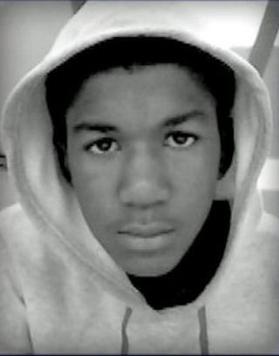 Primary Source: Photograph
Primary Source: Photograph
Treyvon Martin was only 17 when he was killed on his way home from a convenience store in Florida in 2012. His death marked the start of the modern campaign to bring attention to the killing of unarmed African American men and boys.
In 2014, Eric Garner died in New York City, and his death inspired a powerful slogan for the movement. Some people who were watching the incident recorded it on their phones. They said that Garner had just broken up a fight before the police arrived. When a police officer tried to handcuff Garner from behind, he pulled away and said, “Don’t touch me, please.” The officer then put Garner in a chokehold from behind, while other officers came in. After 15 seconds, the officer let go of Garner’s neck but pushed his face into the sidewalk with his hands. Garner said “I can’t breathe” eleven times while lying on the ground. He was motionless and handcuffed for a while before an ambulance came. The police said Garner had a heart attack while being taken to the hospital, where he was pronounced dead an hour later.
 Primary Source: Photograph
Primary Source: Photograph
A protester at a rally in Virginia. “I Can’t Breathe” were Eric Garner’s last words and “I can’t breathe, mama” were some of George Floyd’s last words.
In 2014, a grand jury decided there wasn’t enough evidence to arrest the officer who had caused Eric Garner’s death. This made people in many cities, including New York, Chicago, and Washington, DC angry, and they protested against police brutality. Garner’s last words, “I can’t breathe”, have become a common chant in these protests.
On August 9, 2014, an 18-year-old named Michael Brown, Jr. was shot and killed by a police officer in Ferguson, Missouri, a suburb of St. Louis. People disagree about what happened when the officer first approached Brown, but after a fight, Brown started to run away, and the officer chased him. The officer said that Brown turned and ran at him, but Brown’s friend who was there said that Brown put his hands up after the officer shot at him. According to the friend, the officer then shot Brown many times. Other police officers and people from the city arrived soon after. Brown’s body was left on the road for four hours before being taken away, which made many people angry.
Even before Brown’s death, many people in Ferguson didn’t like the police department. The department had hired mostly White officers who didn’t live in the city, and they pulled over Black drivers for small things like broken lights to give them tickets and make money for the city. Many people saw this as unfair. Also, police departments in many places have had a bad relationship with Black people because they used to help enforce unfair laws that kept Black people from having the same rights as White people.
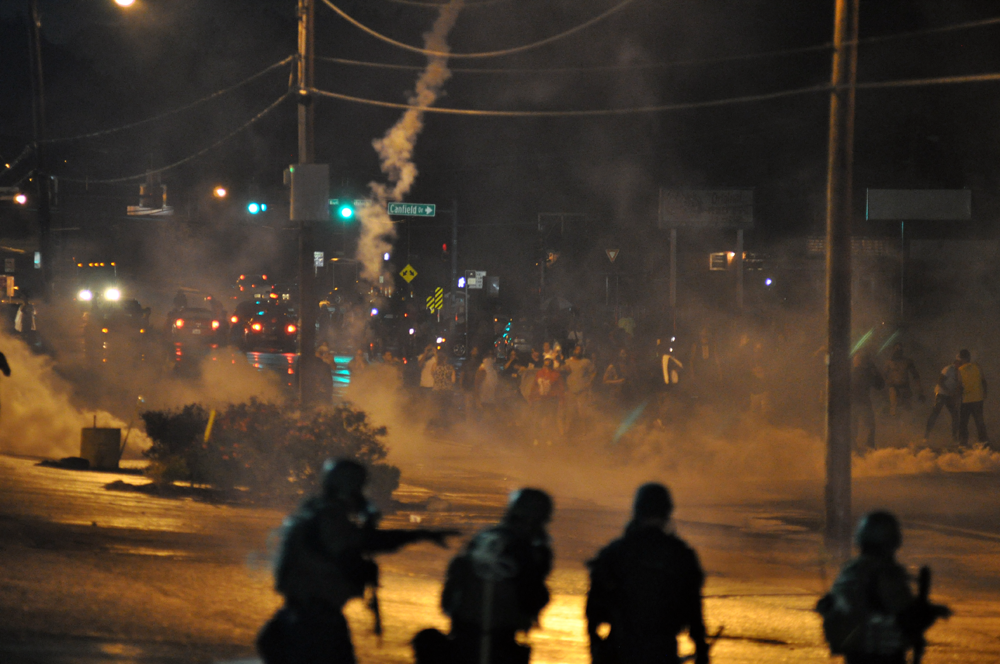 Primary Source: Photograph
Primary Source: Photograph
The unrest in Ferguson, Missouri following the death of Michael Brown. The police were criticized for using militarized tactics against the demonstrators including armored vehicles and tear gas.
Michael Brown’s death caused problems in Ferguson. People protested by saying “Hands up, don’t shoot” for over a week. The media and politicians thought the police were acting like soldiers, not officers. After the September 11 Attacks, the government gave money to police to fight terrorism. But some police bought things like shields, tear gas, and weapons instead. When people protested in Ferguson, they faced these police who looked like an army.
A few months later, a grand jury decided not to charge the police officer who killed Brown. The Department of Justice said that the officer acted in self-defense. This made many people in minority communities feel like police could kill African Americans without getting in trouble.
Three months after Brown’s death, a 12-year-old boy named Tamir Rice was killed by police in Cleveland, Ohio. They thought he had a real gun, but it was actually a toy. The police didn’t try to help him and even handcuffed his sister when she ran to help him. Later, the police weren’t charged because they thought Rice was pulling out a real gun. People protested that police make quick decisions about African Americans without looking at the facts. They also said that the shootings of Rice and Trayvon Martin show that people in America think African American boys and men are dangerous, even when they’re young.
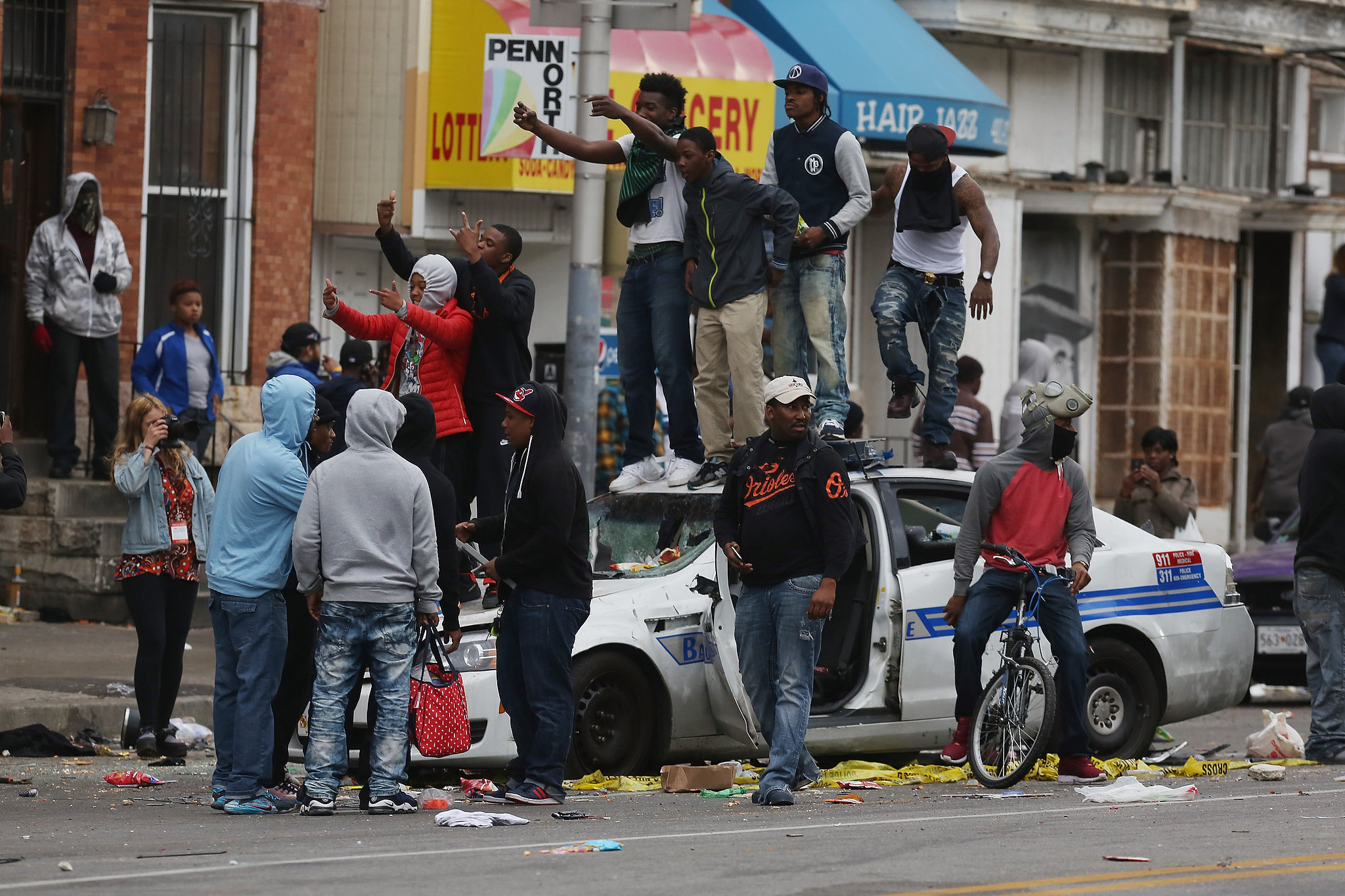 Primary Source: Photograph
Primary Source: Photograph
The death of Freddie Gray launched protests that turned violent in Baltimore, Maryland. Eventually the National Guard was brought to the city to restore order. Baltimore has been one of the nation’s most deeply segregated cities.
In 2015, Freddie Gray, Jr., a 25-year-old man, was arrested by the Baltimore Police Department for having an illegal knife. While he was being taken to the police station in a van, Gray fell into a coma and later died in a hospital. It wasn’t clear how he got hurt, but some people who saw it happen said that the police officers used too much force when they arrested him. The police chief said that the officers didn’t follow the rules by not buckling Gray into the van. Doctors said that Gray was hurt while he was in the van. The state attorney charged six police officers, but none of them were found guilty.
People were upset after Freddie Gray’s death. They started protesting, but things got worse when protests in Baltimore turned violent. Police officers were hurt and lots of people were arrested. After Gray’s funeral, things got even worse. Some people started looting and setting fires to buildings. The governor had to call in the National Guard to help stop the chaos. For many Americans, it reminded them of the urban riots from the 1960s.
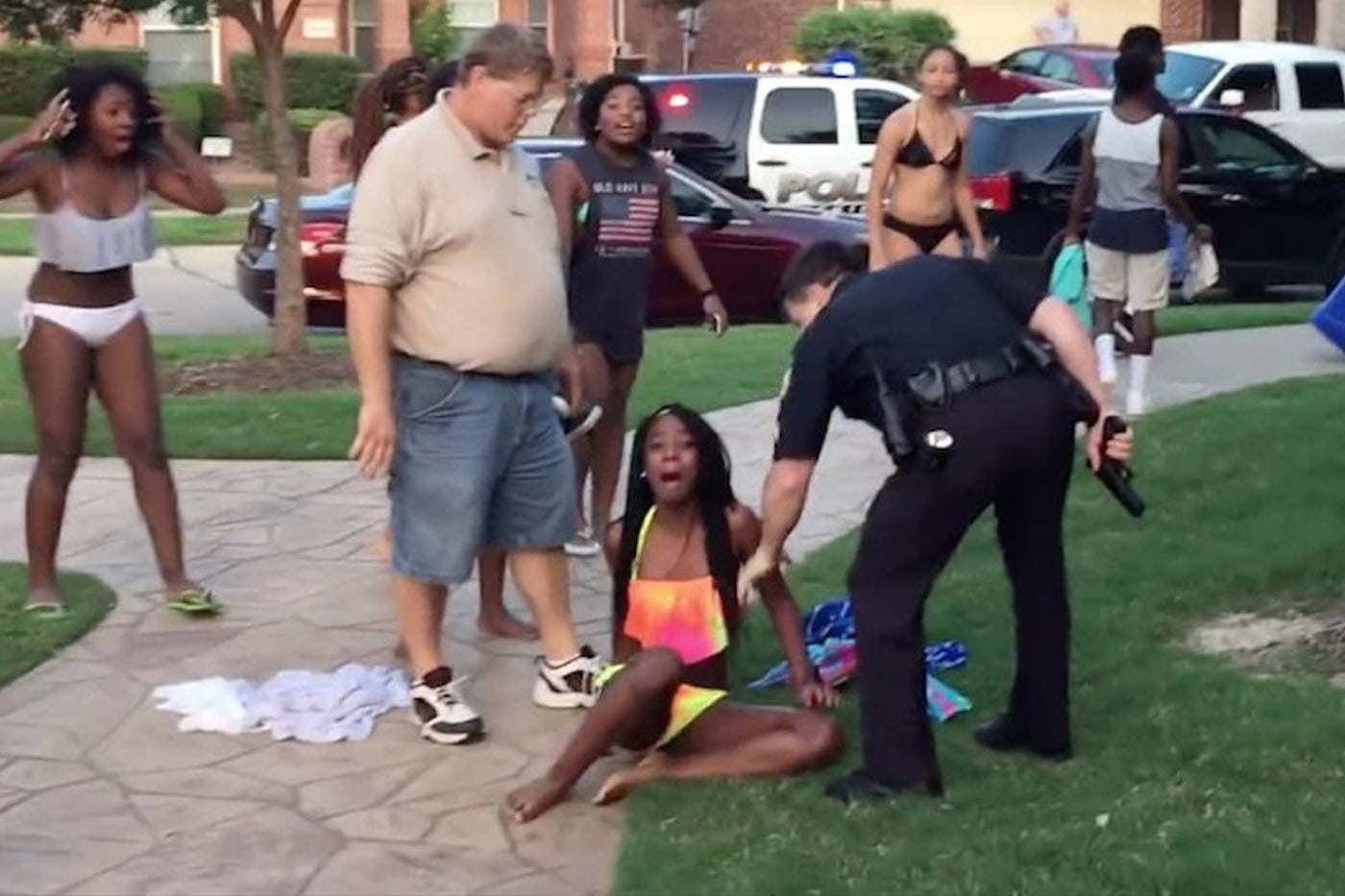 Primary Source: Video
Primary Source: Video
A moment from the video of the intervention at the McKinney pool party in 2015.
People in the Black Lives Matter movement have protested many times after police killed unarmed Black men. They have also protested when police use violence or disrespect people. One example is when a police officer restrained a 15-year-old Black girl at a pool party in McKinney, Texas in 2015. The officer even pulled out his gun, which made protesters think that police use deadly force too quickly when they work with Black people, even if they are young, female, or not carrying a weapon. The officer in the video was suspended from work and then quit later.
In 2015, the Black Lives Matter movement started a campaign called #SayHerName to focus on female victims of police violence. They felt that the media and the Black Lives Matter movement were mostly paying attention to male victims. Breonna Taylor was one of the women the campaign tried to bring attention to. She was a 26-year-old EMT who was killed by police in her apartment. The police thought her boyfriend was getting drugs in the mail and came to her apartment in plain clothes. They claimed they announced they were police, but most of Taylor’s neighbors said they did not hear it. Taylor’s boyfriend thought their house was being invaded and fired his gun. Taylor was killed in the exchange. The police never found any drugs at the apartment. People criticized the police for the way they entered the apartment, which they felt led to the deadly exchange. One officer was charged with endangering the family next door, but no one was charged for Taylor’s death.
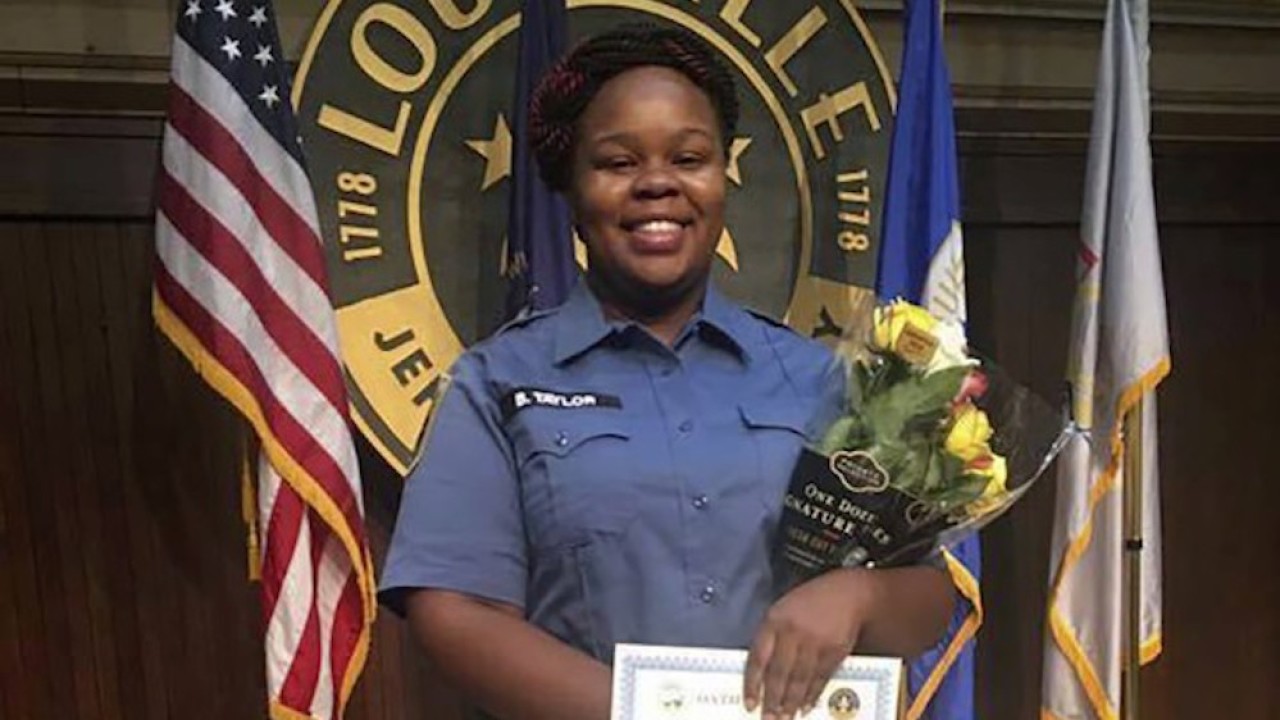 Primary Source: Photograph
Primary Source: Photograph
Breonna Taylor was an EMT in Kentucky. Her death when police raided her apartment inspired the #SayHerName campaign to bring attention to African American women killed by police.
The #SayHerName campaign also wants people to remember Sandra Bland. She was stopped by the police for not using her turn signal while changing lanes. She was taken to jail and three days later she was found dead by hanging. Investigations showed that the police and jail officers did not check on Bland often enough. In 2017, Texas made a new law called the Sandra Bland Act. This law makes sure the police learn how to deal with problems calmly and how to help people who have problems with drugs or mental health issues.
The WNBA also joined the #SayHerName movement. During their 2020 season, they focused on the long history of racism and unfairness that affects people of color. In their first game, the players wore shirts to honor Breonna Taylor and the #SayHerName campaign. The WNBA and the NBA also postponed two days of games to draw attention to violence against African American women.
THE CONFEDERATE FLAG
The Confederate battle flag is a symbol that represents racism and White supremacy. Although it was not used after the Civil War ended in 1865, it was brought back as part of the Georgia state flag in 1956, only two years after segregation was ended in public school. It was also used in protests against integration at the University of Mississippi and was added to the flags of several southern states, including South Carolina. While some White Southerners see the Confederate battle flag as a symbol of their heritage, many others associate it with the defense of slavery and racism. Historian Gordon Rhea wrote in 2011 that White supremacist groups like the Ku Klux Klan and skinheads have used the Confederate battle flag because it represents their ideas that Black people are inferior to White people. Some people argue that the Confederate flag represents heritage, but others question why we should celebrate a heritage that was based on hate and exploitation.
 Primary Source: Photograph
Primary Source: Photograph
The Charleston Church Shooting launched protests aimed at removing symbols of the old Confederacy, especially the Confederate battle flag from government buildings and monuments.
In 2015, a young man who believed in White supremacy killed nine African Americans during a prayer meeting at a church in Charleston, South Carolina. After the attack, people learned that the shooter had posted racist messages online and took pictures with the Confederate battle flag. This event sparked a debate about whether the flag should still be used, because many people think it represents racism and hate.
Because of the public pressure and protests that followed, the South Carolina General Assembly decided to remove the Confederate flag from a memorial on the State Capitol grounds. In 2016, the United States House of Representatives voted to ban the display of Confederate flags at Veterans Administration cemeteries. Some politicians tried to change the ban, but their efforts were unsuccessful.
SPORTS AND POPULAR CULTURE
Protests about racial division have spilled over into many areas of life. In 2015, the student body president of the University of Missouri posted about prejudice and anti-gay feelings on campus. He claimed that people in the back of a passing pickup truck taunted him with racial slurs. He wasn’t alone. Other students shared stories of being called harassed because of their race. Students protested, calling for the university chancellor to resign for not having done enough to deal with racism, homophobia, anti-Semitism, and prejudice on campus. The protesters grew when the school’s football players said they would not practice or play until the chancellor resigned. If they didn’t play, the university would have to pay a $1 million fine. The chancellor resigned.
The National Football League (NFL) has been a place where African American players have used their fame to speak out against racism. Starting in 2016, some athletes kneeled during the playing of the national anthem to protest against police brutality and racism. This became well-known when a quarterback named Colin Kaepernick did it while playing for the San Francisco 49ers. Other NFL players and athletes from other sports teams have also taken part in similar silent protests. The players explained that they chose to kneel as a sign of respect, similar to when a flag is flown at half-mast after a tragedy. Some players have spoken out, saying that even though their fathers served in the military, they still face racial incidents because they are black. In 2017, the protests became more widespread when President Donald Trump criticized the players and called for them to be fired. Over 200 players sat or kneeled in response.
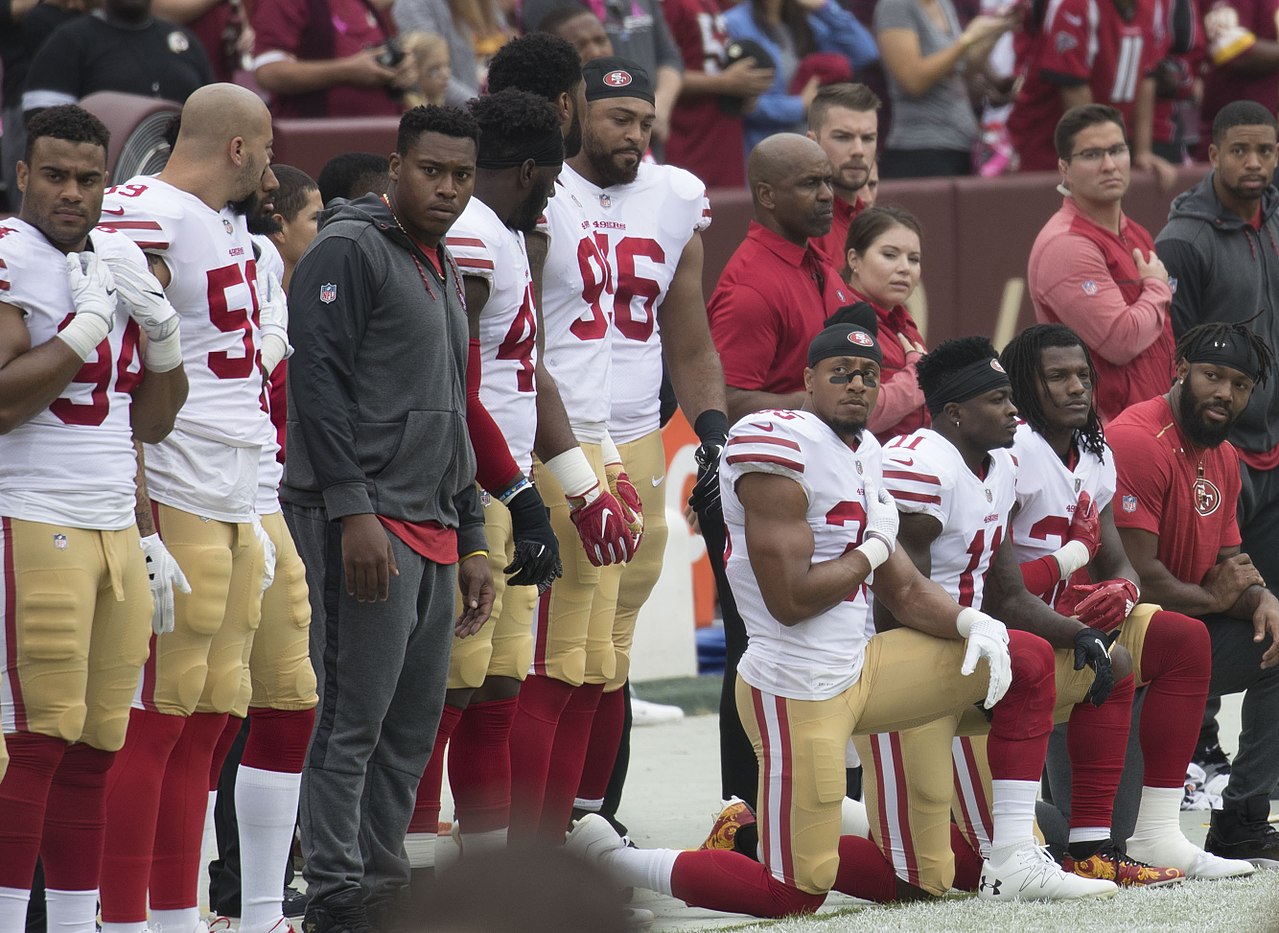 Primary Source: Photograph
Primary Source: Photograph
Members of the NFL’s San Francisco 49ers kneel during the playing of the national anthem before a football game. This particular form of protest was first noticed by the national media when Colin Kaeparnick knelt in 2016.
Many Americans disagree about what the national anthem and player protests mean. Some people think the anthem honors those who died serving in the military or as police officers. Others think it honors America in general. A survey in 2020 found that 52% of Americans thought it was okay for players to kneel during the anthem. However, only 20% of Republicans who took the survey agreed with this.
During the Super Bowl halftime show in 2016, singer Beyoncé made a political statement with her performance of her song Formation. She and her dancers wore black outfits, and they used the Black Power salute, which was made famous by Olympic runners in 1968. Some people, like former New York City mayor Rudy Giuliani, thought the performance was anti-police. He said that he was upset that Beyoncé used the performance to criticize the people who protect her and all of us.
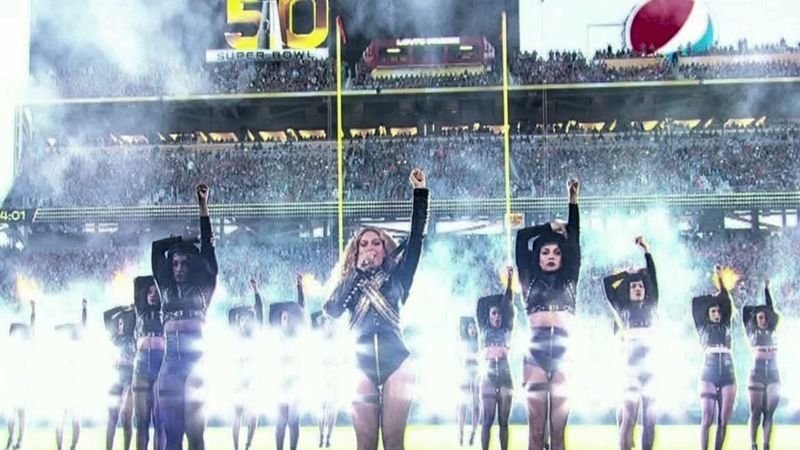 Primary Source: Photograph
Primary Source: Photograph
Beyoncé’s performance at the 2016 Super Bowl Halftime Show bore similarities to the Black Power salute that made some Americans proud and others uneasy.
THE RACIAL JUSTICE MOVEMENT DURING THE TRUMP PRESIDENCY
In 2016, Donald Trump became the President of the United States, and this changed the fight for racial equality. Trump promoted the idea of birtherism, the lie that President Obama wasn’t born in America, which was meant to make people think Obama wasn’t a real president. Trump also used phrases that hinted at his racist beliefs, like saying that America needed more immigrants from countries with mostly White people.
In 2017, a group of people who believed that White people were better than others, called White supremacists, went to Charlottesville, Virginia to protest the removal of a statue of a Confederate general. They carried weapons and flags with racist symbols, and chanted things like “White lives matter”. People who thought this was wrong went to Charlottesville to show that they didn’t support racism. This Unite the Right rally turned violent, and someone drove a car into a crowd of people, killing one person and hurting 19 others. When President Trump was asked about it, he didn’t say that he thought the White supremacists were wrong, but instead said that there were “very fine people on both sides”, which made people think he supported the White supremacists.
The biggest event of the racial justice movement was the protests in the summer of 2020. People were upset because George Floyd, a Black man, was killed by a police officer who knelt on his neck for a long time. People saw videos of what happened on social media and started protesting. The protests spread across the country and to over 2,000 cities and towns. Even though the the COVID-19 Pandemic was raging, between 15 to 26 million people participated in the protests in the United States, which made them the largest in the country’s history. People in over 60 countries also joined in. Most of the protests were peaceful, but some turned into riots, looting, and fighting with the police. Some police also used violence, even with reporters. Over 200 cities put curfews in place, and more than 30 states and Washington, D.C. used the National Guard or military to keep things under control. Even though over 90% of the protests in the country were peaceful, the damage from the looting, arson, and vandalism caused over $1 billion in damage, which was more than the damage caused in Los Angeles in 1992 after police officers were acquitted for beating Rodney King.
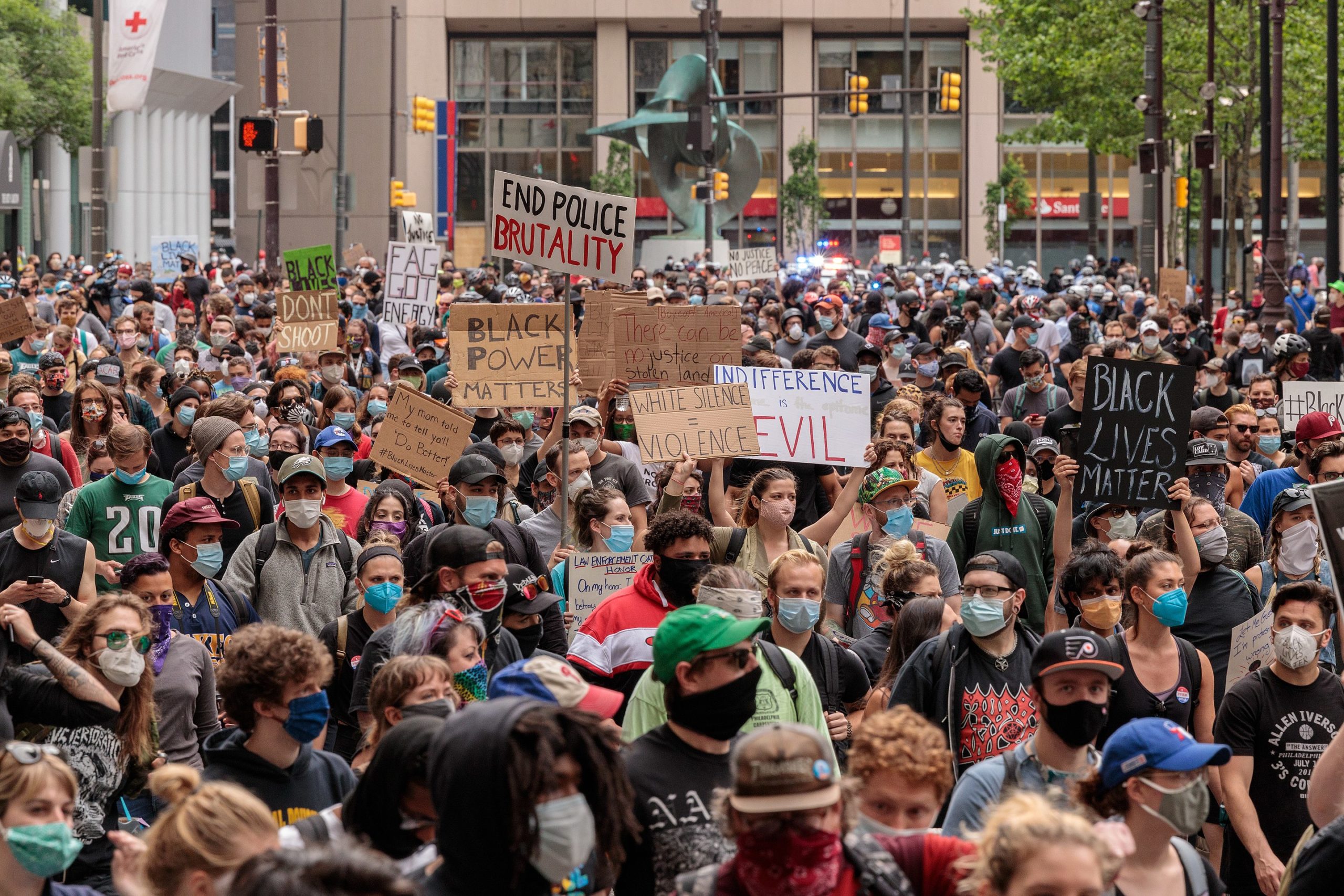 Primary Source: Photograph
Primary Source: Photograph
A rally in Philadelphia during the summer of 2020 following the murder of George Floyd.
President Trump didn’t like the protests and supported the police, which made a lot of young people who support the racial justice movement upset. He wrote on Twitter that the military was with the governor and that if there were any problems, they would take control. He also said, “when the looting starts, the shooting starts.” This tweet was not allowed by Twitter because it talked about violence. Other important people in the government, like the Attorney General and Defense Secretary, agreed with the president’s message that they needed to be in control. When protesters threw things at Secret Service agents and went through barricades near the White House, more than 60 agents were hurt. As a caution, the Secret Service put the White House on lockdown and moved President Trump and his family to a safe place underground for about an hour.
News coverage of the protests upset Trump because he thought people believed he was hiding. He wanted to gain public support again, so he went to a nearby church for a photo. Police officers in special gear used tear gas to force peaceful protesters out of the way, so Trump and some of his team could walk to the church. Trump held up a Bible and posed for a picture in front of a part of the church that was damaged by a fire during earlier protests. Lots of people thought the police using tear gas was too much, and that it took away people’s right to gather together. Leaders from different groups, including the military and different religions, and politicians from both political parties, criticized Trump for what happened. This was one of the times when Trump’s popularity as president was at its lowest.
 Primary Source: Photograph
Primary Source: Photograph
President Trump’s photo op in front of the Ashburton House of the St. John’s Episcopal Church. His decision to have to police use force to clear peaceful protesters so he could take the photo damaged his popularity with voters.
The protests after the killing of George Floyd made people pay attention to the Black Lives Matter movement and the issue of racial justice. The way some police officers acted during the protests made some people angry at them. Some police officers retired or walked off the job. The protests lost some support when some leaders talked about defunding the police. Some people think that defunding the police means taking money away from the police and giving it to social services like housing, substance abuse treatment, or mental health care. Other people think that the police need a big change, going back to when police forces were responsible for enforcing segregation laws, and that social service agencies could do a better job handling some situations that now require police involvement.
Some people started a movement called Blue Lives Matter to support police officers, and they made a flag called the Thin Blue Line Flag. Some people, like former New York City mayor Rudy Giuliani, think that Black Lives Matter is anti-police and that it creates problems instead of solving them. Giuliani and others like him believe that America is not a racist country, and that talking about racism and police violence makes things worse.
 Primary Source: Photograph
Primary Source: Photograph
The Washington, DC mayor renamed a section of 16th Street near the White House Black Lives Matter Plaza and had the words painted on the road.
The protests had widespread consequences. The Georgia legislature voted to change the design of their state flag. Georgia was the last state to incorporate the Confederate battle flag into its design. The military banned displays of the Confederate flag on any base, ship, cemetery, memorial, or battlefield site. NASCAR banned the flag for its racing events. Mrs. Butterworth, Aunt Jemima, Uncle Ben’s and Cream of Wheat changed their names or packaging to remove depictions of African Americans that incorporated historical stereotypes. The online game Fortnite removed police cars and hundreds of racial slurs were taken out of the official Scrabble dictionary. Over a dozen high schools abandoned nicknames like Rebels, Redskins, or Indians. Animated shows such as The Simpsons, Central Park and Family Guy replaced White actors who had been voicing non-White characters. Netflix and other streaming services pulled movies and episodes with racist jokes or offensive themes. Dozens of schools, museums, streets, parks and other public places were renamed so as not to honor people who participated in the Confederacy or were connected with slavery. The Washington, DC mayor renamed the street across from St. John’s Church and the White House Black Lives Matter Plaza and painted those words in giant letters on the road.
The protests had big effects on society. The Georgia state flag was changed because it had the Confederate battle flag on it. The military stopped people from displaying the Confederate flag on bases, ships, cemeteries, and other places. NASCAR also banned the flag from its races. Some companies, such as Mrs. Butterworth, Aunt Jemima, Uncle Ben’s and Cream of Wheat changed their names or packaging to get rid of pictures of African Americans that were based on old stereotypes. Some schools changed their team names because they were offensive. Some TV shows changed who voiced non-White characters. Movies and episodes with racist jokes or ideas were taken off streaming services. Many public places were renamed to not honor people who were part of the Confederacy or connected with slavery. The street by St. John’s Church and the White House in Washington, DC was renamed Black Lives Matter Plaza and had those words painted on it.
Police officers across the country criticized the officers who had arrested George Floyd and around the country people tried to make changes to prevent anything like it from happening again. Many reforms were put in place, including bans on choke holds, training programs to de-escalate conflicts, and bans on tear gas, pepper spray, and rubber bullets. More officers are being trained and assigned to community policing to develop relationships with the people they serve. Body cameras have become more common for recording police activities. In the end, the four police officers involved in George Floyd’s arrest were arrested themselves, and the officer who knelt on his neck was found guilty in April 2021, a rare outcome in cases of police violence. The trials for the other three officers are scheduled for August 2021.
The fight for racial justice is expanding to include more than just African Americans. During the coronavirus pandemic, Asian Americans faced violence because some people blamed them for the virus. This kind of prejudice against Asian Americans is not new; it has been around since the 1800s. There was a big increase in hate crimes against Asians in 2020, especially in big cities like New York and Los Angeles. Some people think President Trump made things worse by using words like “Wuhan Virus” and “China Virus.” Unlike with Black Lives Matter, most of the attacks against Asians were not done by police officers. Anyone could be victim of these crimes, like a man who was spat at and told to “go back to China” while he was out for a run. One of the worst attacks was when a man killed eight workers at three massage parlors in Atlanta, six of whom were Asian women. This event, along with others, led Asian American and Pacific Islander groups to organize protests and campaigns to stop the hate. They also used the phrase “Stop AAPI Hate” as part of their movement, joining with Black Lives Matter in the fight for justice.
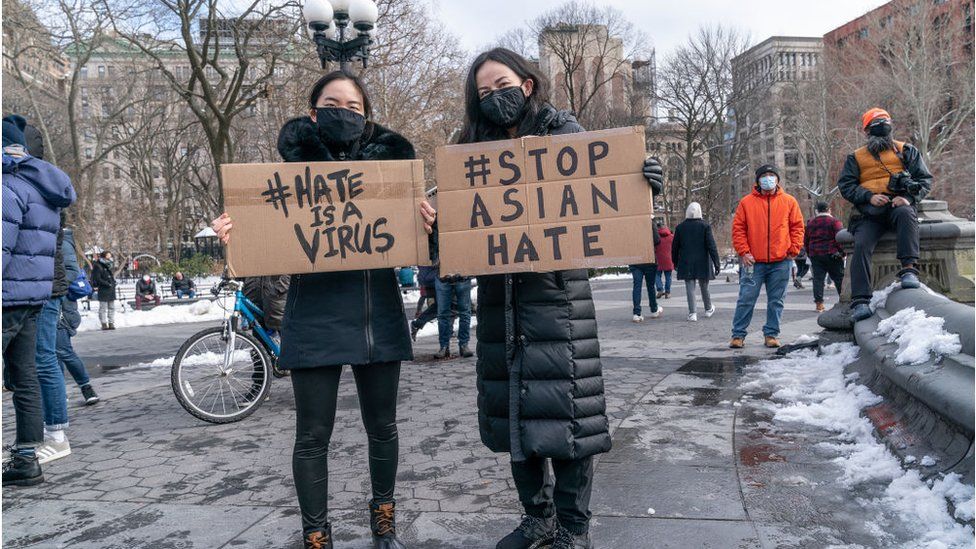 Primary Source: Photograph
Primary Source: Photograph
Protests against anti-Asian prejudice and violence became part of the racial justice movement during the coronavirus pandemic.
VOTING RIGHTS
In 2013, the United States Supreme Court invalidated a part of the Voting Rights Act in the case Shelby County v. Holder. Passed in 1965 as part of the Civil Rights Movement, the Voting Rights Act required states with a history of racial discrimination to get approval from the federal government before changing their election laws. The Court said that the United States had changed a lot since the 1960s and that racial discrimination in voting had ended, so the law was not needed anymore.
After the decision, some state governments controlled by Republicans passed laws that they said were meant to stop voter fraud. However, Democrats and groups that support minority rights said that the real goal of these laws was voter suppression, that is, to make it harder for people who are minorities or have lower incomes to vote. They think that the idea of voter fraud is just an excuse to stop these people from voting.
 Primary Source: Editorial Cartoon
Primary Source: Editorial Cartoon
This cartoon comments on both the long lines some voters have faced on Election Day when many people have to vote in one place, and the long history of disenfranchisement African Americans have faced in America.
Some states require voters to show identification before they can vote. These voter ID laws may seem like a good idea, but it can be hard for some people to get the right ID, especially if they move a lot or don’t have a driver’s license. Some states have also made it harder for people to get the right ID by closing offices where they can get it. Some types of ID are allowed, like military IDs or gun permits, but others, like state employee or university IDs, are not.
Republicans have also closed down polling places in minority neighborhoods, making it harder for people to vote. They have also stopped early voting and proposed banning convicted felons from voting. Critics say that these actions disproportionately affect minority voters and are just an excuse to save money. When polling places are closed, people have to travel further and wait longer to vote. This can result in fewer minority voters being able to cast their ballots. In response to these rules, many Democrats have suggested making Election Day a national holiday or moving elections to a Saturday to make it easier for everyone to vote.
CONCLUSION
Ta-Nehisi Coates wrote in The Atlantic in 2015 that some people used the phrase “post-racial” to talk about progress during the Obama era. But others say this is just a way for white people to avoid dealing with the lasting effects of slavery.
Some people think post-racial politics is about taking strong action to create equal opportunities for everyone and fix police misconduct. They say that focusing on division in the media makes it harder to heal racial tensions and work for justice. Instead, they want people to work together to create harmony and make progress.
So, there are different opinions about what post-racial means. Do you think we have reached a time when we don’t see race? Or do you think we need to work together to make progress on issues of racial justice? What do you think a post-racial America would look like?
What do you think? Do you think we will ever have a post-racial America?
CONTINUE READING
- Previous: The American People
- Next: The Digital Revolution

SUMMARY
BIG IDEA: During the 2010s the Black Lives Matter movement emerged as a response to police violence against African American men. The movement expanded as events brought a wide variety of problems facing minority communities to the nation’s attention. Despite the election of the first African American president, the past decade shows how divided and unequal America remains.
Even after the Civil Rights Movement of the 1960s, America remains a racially segregation nation. People tend to live in communities with other people of their same race. In some places such as Flint, Michigan or New Orleans after Hurricane Katrina, White community leaders have been accused of harming African American neighborhoods by neglecting to provide proper services.
Barack Obama was elected in 2008 as the first African American president. In the beginning, he encouraged people to think that the nation was moving past its divided past, but later he explicitly dealt with race in speeches.
During Obama’s presidency, new cell phone cameras and social media made evidence of shootings of unarmed African Americans common and the Black Lives Matter movement grew to bring attention to this ongoing problem. Protests took place after numerous shootings. Protests in Ferguson, Missouri and Baltimore, Maryland turned violent and were met with police using military equipment and tactics.
A shooting in an African American church in Charleston, South Carolina by a White nationalist led to a movement to remove symbols of the Confederacy, especially the old Confederate battle flag and statues of Confederate soldiers.
Athletes have supported these protests by kneeling during the national anthem. Beyoncé protested by using Black Power symbolism during her performance at the Super Bowl.
Other groups such as African American women and Asian and Pacific Islanders have also begun movements to address racism and violence.
President Trump was criticized by many Americans for his comments and actions related to racial conflicts. Some felt that he was encouraging White supremacists or disrespecting the right of people to assemble and protest.
The most significant racial justice protests since the 1960s happened in the summer of 2020 when marches were held in hundreds of cities to protest police violence after the murder of George Floyd. Numerous changes have been enacted as a result, including changing names and increased efforts to make sure minority groups are represented and portrayed respectfully in business and popular culture.
BLM has been criticized as anti-police and encouraging racial division. Although there has not been a decline in police shootings, police departments around the country have implemented reforms such as an increased emphasis on community policing, banning some tactics, and the use of body cameras.
The Shelby County v. Holder case invalidated parts of the Voting Rights Act of 1965 and in many Republican-controlled states new restrictions on voting rights have been enacted.

VOCABULARY
![]()
PEOPLE AND GROUPS
Barack Obama: First African American president. He is a Democrat and was elected in 2008 and reelected 2012.
Treyvon Martin: African American teenager who was murdered in 2012 while walking home from buying candy from a convenience store in Florida. His death sparked the beginnings of the Black Lives Matter movement.
Eric Garner: African American man who died in 2014 after being held in a chokehold by New York City Police. His last words were “I can’t breathe” which became a slogan of anti-police brutality protests.
Michael Brown, Jr.: African American teenager killed by police in 2014 in Ferguson, Missouri. Protests after his death were the first to feature large numbers of participants organized by the Black Lives Matter movement.
Tamir Rice: 12-year-old African American boy killed by police in 2014 who believed he was carrying a gun. It turned out to be an air pistol. His death was widely protested as part of the Black Lives Matter movement.
Freddie Gray, Jr.: African American man who died in a police van from spinal cord injuries in 2015 in Baltimore. His death sparked protests that turned violent.
Breonna Taylor: African American woman killed when police attempted to carry out a no-knock warrant of her apartment. Her death helped give rise to the #SayHerName campaign.
Sandra Bland: An African American woman who died while in police custody. Her story gained national attention through the #SayHerName movement and led to police reforms in Texas.
Colin Kaepernick: NFL quarterback who knelt during The Star Spangled Banner beginning in 2016. His actions launched a wider use of that non-violent protest among professional athletes.
Beyoncé: Pop star who used Black Power symbolism to protest treatment of African Americans by police during the 2016 Super Bowl Halftime Show.
George Floyd: African American man who died when a police officer knelt on his neck for over nine minutes. His death in 2020 sparked the largest racial justices protests in American history.
![]()
KEY IDEAS
White Flight: The movement of Whites out of inner cities into suburbs in the 1970s and 1980s that resulted in poorer urban cores populated by African Americans and Hispanics surrounded by suburbs of almost all White residents.
Community Policing: Police practices that include meeting people instead of only riding in cars, and doing public relations activities such as running children’s sports leagues.
Body Cameras: Small digital video cameras worn by police officers.
Bertherism: The lie that President Barack Obama was not born in the United States. Before running for president himself, Donald Trump was famous for spreading this lie.
Dog Whistle: A phrase or comment used by politicians to show support for a group but that other groups of voters will not notice or find offensive.
Defund the Police: A rallying cry and policy proposal that grew out of the George Floyd protests of 2020. It frightens some Americans who favor law-and-order and lowered overall public support for the protests.
Voter Suppression: Any action designed to make voting harder. After the Shelby County v. Holder Supreme Court case, numerous laws and policies have been implemented to this effect.
![]()
SPEECHES, SLOGANS & SYMBOLS
2002 Democratic National Convention Keynote Speech: Speech by then-Senator Barack Obama in which he rejected divisions in America. It is sometimes called the “Purple America” speech in reference to the merging of blue and red. Obama’s performance propelled him to national fame.
A More Perfect Union Speech: Speech by Barack Obama during the 2008 presidential campaign in which he explicitly addressed the issue of race. Some political historians regard it as a turning point in the campaign.
I Can’t Breathe: Eric Garner’s last words. They became a slogan of protesters against police brutality.
Hands Up, Don’t Shoot: The last words some believe Michael Brown said before being killed by police in 2014. They became a slogan of the Black Lives Matter movement.
Confederate Battle Flag: The flag carried by troops from the South into battle during the Civil War. It was resurrected in the 1960s by White Southerners who opposed the Civil Rights Movement and is now a powerful symbol of hate and racism.
Thin Blue Line Flag: A modified American flag that is black and white with one blue line across the center. It is used to show support for the police.
![]()
LOCATIONS
Lower Ninth Ward: Mostly African American neighborhood in New Orleans that was devastated by flooding in 2005 after Hurricane Katrina.
![]()
COURT CASES
Shelby County v. Holder: 2013 Supreme Court case in which the Court ruled that large sections of the 1965 Voting Rights Act no longer applied. After the ruling, Republican politicians in many states implemented changes designed to suppress the minority vote.
![]()
EVENTS
Flint Water Crisis: Health crisis revealed in 2014 in which the mostly African American residents of Flint, Michigan were drinking tap water contaminated with lead.
Black Lives Matter (BLM): Racial justice movement that developed around 2014 and focuses on police brutality. It is led by younger Americans rather than the generation that led the Civil Rights Movement of the 1960s.
Ferguson Unrest: Weeklong protests and confrontations between protesters and law enforcement after the death of Michael Brown in 2014. Protests restarted after the announcement that the officer who shot him would not be indicted, and again on the anniversary of Brown’s death.
2015 Baltimore Protest: Violent unrest after the death of Freddie Gray in 2015. The protests resulted in arson, arrests, injuries to police and the calling of the National Guard to restore order.
McKinney Pool Party: 2015 incident in Texas in which a White police officer tackled an African American teenage girl outside a pool party and then later pulled his gun. The incident was captured on video.
SayHerName: An outgrowth of the Black Lives Matter movement focuses on bringing attention to police violence against African American Women.
Charleston Church Shooting: Mass shooting of African Americans at the Emanuel African Methodist Episcopal Church in 2015 by a White supremacist. The attack sparked a debate over public displays of the Confederate battle flag.
University of Missouri Protests: Protests in 2015 at the University of Missouri when students decided the school’s chancellor had not done enough to address racism and hate on campus. The protests succeeded when the school’s football team refused to play.
2016 Super Bowl Halftime Show: Performance by Beyoncé in which she used Black Power symbolism to protest treatment of African Americans by police.
Unite the Right: A rally held by various White supremist groups in 2017 in Charlottesville. Trump’s comments about the rally resulted in the lowest approval rating of his presidency.
George Floyd Protests: The largest racial justice protests in American history. They were held in dozens of cities around the nation during the summer of 2020.
Trump’s Photo Op at St. John’s Church: During the George Floyd protests in the summer of 2020 President Trump ordered police to forcibly remove peaceful protesters so he could have a photo taken holding a Bible in front of a church near the White House. His attempt to capture public support backfired.
Blue Lives Matter: Slogan of a movement in support of police officers in response to criticism from the Black Lives Matter movement.
Stop AAPI Hate: Movement that emerged during the coronavirus pandemic to combat violence and prejudice against Asian Americans and Pacific Islanders.
![]()
LAWS & RESOLUTIONS
Stand-Your-Ground Laws: Laws that permit citizens to use deadly force to defend themselves if they feel threatened.
Voter ID Laws: Laws that require voters to show photo identification. Proponents claim they will stop voter fraud. Opponents claim they make voting harder, especially for the elderly, minorities and the poor
